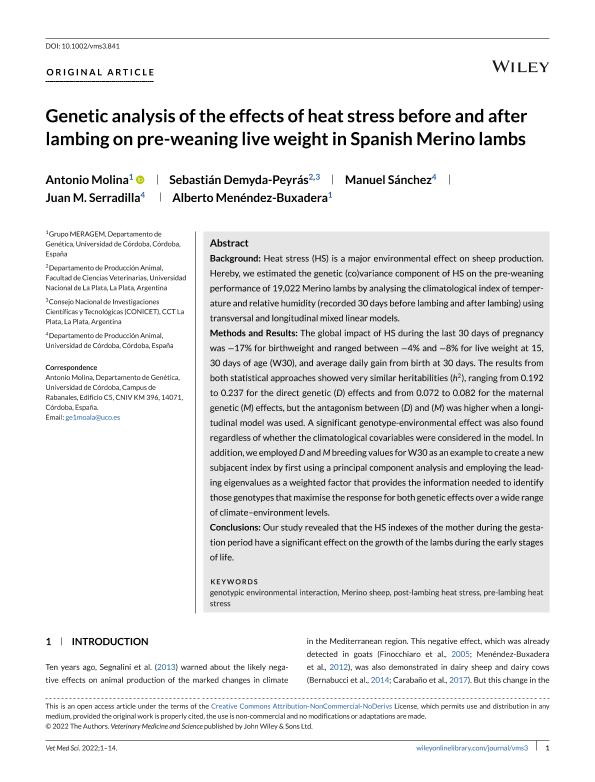Mostrar el registro sencillo del ítem
dc.contributor.author
Molina, Antonio
dc.contributor.author
Demyda-peyrás, Sebastian

dc.contributor.author
Sánchez, Manuel
dc.contributor.author
Serradilla, Juan M.
dc.contributor.author
Menéndez Buxadera, Alberto
dc.date.available
2023-07-05T12:08:20Z
dc.date.issued
2022-07
dc.identifier.citation
Molina, Antonio; Demyda-peyrás, Sebastian; Sánchez, Manuel; Serradilla, Juan M.; Menéndez Buxadera, Alberto; Genetic analysis of the effects of heat stress before and after lambing on pre-weaning live weight in Spanish Merino lambs; John Wiley & Sons; Veterinary Medicine and Science; 8; 4; 7-2022; 1721-1734
dc.identifier.issn
2053-1095
dc.identifier.uri
http://hdl.handle.net/11336/202411
dc.description.abstract
Background: Heat stress (HS) is a major environmental effect on sheep production. Hereby, we estimated the genetic (co)variance component of HS on the pre-weaning performance of 19,022 Merino lambs by analysing the climatological index of temperature and relative humidity (recorded 30 days before lambing and after lambing) using transversal and longitudinal mixed linear models. Methods and Results: The global impact of HS during the last 30 days of pregnancy was −17% for birthweight and ranged between −4% and −8% for live weight at 15, 30 days of age (W30), and average daily gain from birth at 30 days. The results from both statistical approaches showed very similar heritabilities (h2), ranging from 0.192 to 0.237 for the direct genetic (D) effects and from 0.072 to 0.082 for the maternal genetic (M) effects, but the antagonism between (D) and (M) was higher when a longitudinal model was used. A significant genotype-environmental effect was also found regardless of whether the climatological covariables were considered in the model. In addition, we employed D and M breeding values for W30 as an example to create a new subjacent index by first using a principal component analysis and employing the leading eigenvalues as a weighted factor that provides the information needed to identify those genotypes that maximise the response for both genetic effects over a wide range of climate–environment levels. Conclusions: Our study revealed that the HS indexes of the mother during the gestation period have a significant effect on the growth of the lambs during the early stages of life.
dc.format
application/pdf
dc.language.iso
eng
dc.publisher
John Wiley & Sons

dc.rights
info:eu-repo/semantics/openAccess
dc.rights.uri
https://creativecommons.org/licenses/by-nc-nd/2.5/ar/
dc.subject
GENOTYPIC ENVIRONMENTAL INTERACTION
dc.subject
MERINO SHEEP
dc.subject
POST-LAMBING HEAT STRESS
dc.subject
PRE-LAMBING HEAT STRESS
dc.subject.classification
Tecnología GM, clonación de ganado, selección asistida, diagnósticos, tecnología de producción de biomasa, etc.

dc.subject.classification
Biotecnología Agropecuaria

dc.subject.classification
CIENCIAS AGRÍCOLAS

dc.title
Genetic analysis of the effects of heat stress before and after lambing on pre-weaning live weight in Spanish Merino lambs
dc.type
info:eu-repo/semantics/article
dc.type
info:ar-repo/semantics/artículo
dc.type
info:eu-repo/semantics/publishedVersion
dc.date.updated
2023-07-05T11:02:52Z
dc.journal.volume
8
dc.journal.number
4
dc.journal.pagination
1721-1734
dc.journal.pais
Estados Unidos

dc.description.fil
Fil: Molina, Antonio. Universidad de Córdoba; España
dc.description.fil
Fil: Demyda-peyrás, Sebastian. Consejo Nacional de Investigaciones Científicas y Técnicas; Argentina. Universidad Nacional de La Plata; Argentina
dc.description.fil
Fil: Sánchez, Manuel. Universidad de Córdoba; España
dc.description.fil
Fil: Serradilla, Juan M.. Universidad de Córdoba; España
dc.description.fil
Fil: Menéndez Buxadera, Alberto. Universidad de Córdoba; España
dc.journal.title
Veterinary Medicine and Science
dc.relation.alternativeid
info:eu-repo/semantics/altIdentifier/doi/http://dx.doi.org/10.1002/vms3.841
Archivos asociados
